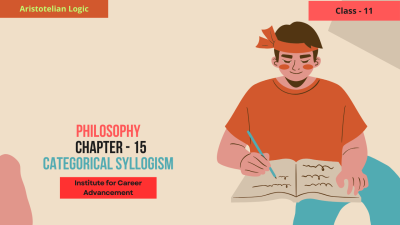Courses


 Compare
Compare
J.S. Mill's Utilitarianism is a significant ethical theory that focuses on maximizing happiness and minimizing suffering for the greatest number of people. Here's a breakdown: Key Concepts: Greatest Happiness Principle: This is the fundamental principle of utilitarianism. It states that actions are right in proportion as they tend to promote happiness, wrong as they tend to produce unhappiness. Happiness: Mill defines happiness as pleasure and the absence of pain. He distinguishes between higher and lower pleasures, arguing that intellectual and moral pleasures are of higher quality than purely sensual ones. Consequentialism: Utilitarianism is a consequentialist theory, meaning that the moral worth of an action is determined solely by its consequences. Impartiality: Utilitarianism emphasizes impartiality. Everyone's happiness counts equally, regardless of their social status, relationships, or personal connections to the decision-maker. J.S. মিল 'স ইউটিলিটেরিয়ানিজম একটি উল্লেখযোগ্য নৈতিক তত্ত্ব যা সর্বাধিক সংখ্যক মানুষের জন্য সুখ সর্বাধিকতর করা এবং দুর্ভোগ হ্রাস করার উপর দৃষ্টি নিবদ্ধ করে। এখানে একটি ভাঙ্গনঃ মূল ধারণাগুলিঃ সর্বাধিক সুখের নীতিঃ এটি উপযোগবাদের মৌলিক নীতি। এতে বলা হয়েছে যে কর্মগুলি অনুপাতে সঠিক কারণ তারা সুখের প্রচার করে, ভুল কারণ তারা অসুখী হওয়ার প্রবণতা তৈরি করে। সুখঃ মিল সুখকে আনন্দ এবং ব্যথার অনুপস্থিতি হিসাবে সংজ্ঞায়িত করেন। তিনি উচ্চতর এবং নিম্নতর সুখের মধ্যে পার্থক্য করেন, যুক্তি দেন যে বুদ্ধিবৃত্তিক এবং নৈতিক সুখ বিশুদ্ধ কামুক সুখের চেয়ে উচ্চতর মানের। ফলস্বরূপবাদঃ উপযোগবাদ একটি ফলস্বরূপবাদী তত্ত্ব, যার অর্থ কোনও কর্মের নৈতিক মূল্য কেবল তার পরিণতি দ্বারা নির্ধারিত হয়। নিরপেক্ষতাঃ উপযোগবাদ নিরপেক্ষতার উপর জোর দেয়। সামাজিক অবস্থান, সম্পর্ক বা সিদ্ধান্ত গ্রহণকারীর সঙ্গে ব্যক্তিগত সংযোগ নির্বিশেষে প্রত্যেকের সুখ সমানভাবে গুরুত্বপূর্ণ।
0 Lessons
Hours

 Compare
Compare
Studying Immanuel Kant's Deontology in Class 12 is crucial for several key reasons: Understanding Ethical Foundations: Duty-Based Ethics: Deontology introduces students to a fundamentally different ethical framework, focusing on duty and moral obligations rather than consequences or character. Rationality and Autonomy: It emphasizes the importance of reason and individual autonomy in moral decision-making. Developing Critical Thinking and Argumentation Skills: Universalizability: Kant's concept of the Categorical Imperative encourages students to critically examine their actions and consider whether they could consistently will that everyone act in the same way. Identifying Contradictions: It helps students identify potential contradictions in moral rules and evaluate the consistency of their own ethical beliefs. Exploring Diverse Perspectives: Beyond Consequentialism: Deontology provides a powerful alternative to consequentialist theories like utilitarianism, broadening students' understanding of ethical frameworks. Human Rights and Justice: Kant's ideas have had a profound impact on our understanding of human rights, justice, and international law. Engaging in Meaningful Discussions: Ethical Dilemmas: Deontology provides a framework for analyzing and discussing complex ethical dilemmas, such as those related to lying, breaking promises, and the treatment of others. By studying Kant's Deontology, students gain a deeper understanding of ethical principles, develop critical thinking and argumentation skills, and are better equipped to engage in thoughtful discussions about moral issues facing individuals and society. দ্বাদশ শ্রেণিতে ইমানুয়েল কান্টের ডিওন্টোলজি অধ্যয়ন করা বেশ কয়েকটি মূল কারণে গুরুত্বপূর্ণঃ নৈতিক ভিত্তিগুলি বোঝাঃ কর্তব্য-ভিত্তিক নীতিশাস্ত্রঃ ডিওন্টোলজি শিক্ষার্থীদের একটি মৌলিকভাবে ভিন্ন নৈতিক কাঠামোর সাথে পরিচয় করিয়ে দেয়, পরিণতি বা চরিত্রের পরিবর্তে কর্তব্য এবং নৈতিক বাধ্যবাধকতার দিকে মনোনিবেশ করে। যুক্তিবাদিতা এবং স্বায়ত্তশাসনঃ এটি নৈতিক সিদ্ধান্ত গ্রহণে যুক্তি এবং ব্যক্তিগত স্বায়ত্তশাসনের গুরুত্বের উপর জোর দেয়। সমালোচনামূলক চিন্তাভাবনা এবং যুক্তি দেওয়ার দক্ষতার বিকাশঃ সর্বজনীনকরণঃ কান্টের ক্যাটেগোরিকাল ইম্পারেটিভের ধারণাটি শিক্ষার্থীদের তাদের ক্রিয়াকলাপগুলি সমালোচনামূলকভাবে পরীক্ষা করতে এবং বিবেচনা করতে উত্সাহিত করে যে তারা ধারাবাহিকভাবে প্রত্যেকে একইভাবে কাজ করতে পারে কিনা। দ্বন্দ্ব সনাক্তকরণঃ এটি শিক্ষার্থীদের নৈতিক নিয়মের সম্ভাব্য দ্বন্দ্বগুলি সনাক্ত করতে এবং তাদের নিজস্ব নৈতিক বিশ্বাসের সামঞ্জস্য মূল্যায়ন করতে সহায়তা করে। বিভিন্ন দৃষ্টিভঙ্গি অন্বেষণ করাঃ ফলস্বরূপবাদের বাইরেঃ ডিওন্টোলজি উপযোগবাদের মতো ফলস্বরূপবাদী তত্ত্বগুলির একটি শক্তিশালী বিকল্প প্রদান করে, যা নৈতিক কাঠামো সম্পর্কে শিক্ষার্থীদের বোঝাপড়া বিস্তৃত করে। মানবাধিকার ও ন্যায়বিচারঃ মানবাধিকার, ন্যায়বিচার এবং আন্তর্জাতিক আইন সম্পর্কে আমাদের বোধগম্যতায় কান্টের ধারণাগুলি গভীর প্রভাব ফেলেছে। অর্থপূর্ণ আলোচনায় অংশ নেওয়াঃ নৈতিক দ্বিধাদ্বন্দ্বঃ ডিওন্টোলজি জটিল নৈতিক দ্বিধাদ্বন্দ্ব বিশ্লেষণ এবং আলোচনার জন্য একটি কাঠামো সরবরাহ করে, যেমন মিথ্যা বলা, প্রতিশ্রুতি ভঙ্গ করা এবং অন্যদের সাথে আচরণ সম্পর্কিত। কান্টের ডিওন্টোলজি অধ্যয়নের মাধ্যমে, শিক্ষার্থীরা নৈতিক নীতিগুলি সম্পর্কে গভীর ধারণা অর্জন করে, সমালোচনামূলক চিন্তাভাবনা এবং যুক্তি দক্ষতা বিকাশ করে এবং ব্যক্তি ও সমাজের মুখোমুখি নৈতিক সমস্যাগুলি সম্পর্কে চিন্তাশীল আলোচনায় জড়িত হওয়ার জন্য আরও ভালভাবে সজ্জিত হয়।
0 Lessons
Hours

 Compare
Compare
Aristotle's Virtue Ethics is a prominent ethical theory that emphasizes the importance of developing good character traits (virtues) for living a fulfilling and happy life. Key Concepts: Eudaimonia (Happiness): Aristotle believed that the ultimate human good is happiness (eudaimonia), which he defined as a state of flourishing or well-being. Virtue as Excellence: Virtues are not just moral rules, but rather excellences of character that enable individuals to live well. They are dispositions to act and feel in the right way, at the right time, and for the right reasons. The Golden Mean: Aristotle argued that virtue lies in finding the "golden mean" between two extremes. For example, courage is the mean between cowardice (deficiency) and recklessness (excess). Practical Wisdom (Phronesis): This is the ability to apply virtuous principles to specific situations in a wise and discerning manner. It involves understanding the nuances of a situation and acting accordingly. Key Virtues: Aristotle identified a range of virtues, including: Courage Temperance Justice Wisdom Generosity Friendliness Honesty Significance: Focus on Character: Virtue ethics shifts the focus from specific actions to the development of good character. Enduring Relevance: Aristotle's ideas continue to have a significant impact on contemporary ethical thought. Emphasis on Human Flourishing: The emphasis on eudaimonia highlights the importance of living a meaningful and fulfilling life. অ্যারিস্টটলের ভর্চু এথিক্স একটি বিশিষ্ট নৈতিক তত্ত্ব যা একটি পরিপূর্ণ এবং সুখী জীবনযাপনের জন্য ভাল চরিত্রের বৈশিষ্ট্য (গুণাবলী) বিকাশের গুরুত্বের উপর জোর দেয়। মূল ধারণাগুলিঃ ইউডাইমোনিয়া (সুখ) অ্যারিস্টটল বিশ্বাস করতেন যে মানুষের সর্বোত্তম মঙ্গল হল সুখ (ইউডাইমোনিয়া) যা তিনি সমৃদ্ধি বা সুস্থতার অবস্থা হিসাবে সংজ্ঞায়িত করেছেন। উৎকর্ষ হিসাবে সদ্গুণঃ সদ্গুণগুলি কেবল নৈতিক নিয়ম নয়, বরং চরিত্রের উৎকর্ষ যা ব্যক্তিদের ভালভাবে বাঁচতে সক্ষম করে। এগুলি সঠিক উপায়ে, সঠিক সময়ে এবং সঠিক কারণে কাজ করার এবং অনুভব করার স্বভাব। দ্য গোল্ডেন মিনঃ অ্যারিস্টটল যুক্তি দিয়েছিলেন যে দুটি চরমপন্থার মধ্যে "সোনার গড়" খুঁজে পাওয়ার মধ্যে পুণ্য নিহিত। উদাহরণস্বরূপ, সাহস হল কাপুরুষতা (ঘাটতি) এবং বেপরোয়া (অতিরিক্ত) এর মধ্যবর্তী মাধ্যম। ব্যবহারিক প্রজ্ঞা (Phronesis) এটি একটি বিজ্ঞ এবং বিচক্ষণ পদ্ধতিতে নির্দিষ্ট পরিস্থিতিতে গুণী নীতিগুলি প্রয়োগ করার ক্ষমতা। এর সঙ্গে কোনও পরিস্থিতির সূক্ষ্মতা বোঝা এবং সেই অনুযায়ী কাজ করা জড়িত। মূল গুণাবলিঃ অ্যারিস্টটল বিভিন্ন গুণাবলী চিহ্নিত করেছেন, যার মধ্যে রয়েছেঃ সাহস। মেজাজ। ন্যায়বিচার প্রজ্ঞা। উদারতা। বন্ধুত্ব। সততা। তাৎপর্যঃ চরিত্রের প্রতি মনোনিবেশ করুনঃ সদ্গুণের নৈতিকতা নির্দিষ্ট কর্ম থেকে ভাল চরিত্রের বিকাশের দিকে মনোনিবেশ করে। স্থায়ী প্রাসঙ্গিকতাঃ অ্যারিস্টটলের ধারণাগুলি সমসাময়িক নৈতিক চিন্তার উপর উল্লেখযোগ্য প্রভাব অব্যাহত রেখেছে। মানব সমৃদ্ধির উপর জোরঃ ইউডাইমোনিয়ার উপর জোর দেওয়া একটি অর্থপূর্ণ এবং পরিপূর্ণ জীবনযাপনের গুরুত্বকে তুলে ধরে।
0 Lessons
Hours

 Compare
Compare
The Divine Command Theory is a prominent ethical theory that proposes that moral obligations are derived directly from the commands of God. Key Concepts: God as the Source of Morality: This theory posits that what is morally right is simply what God commands, and what is morally wrong is what God forbids. Obedience as Virtue: The primary virtue within this framework is obedience to God's will. No Independent Moral Standard: There is no independent standard of good or evil that exists outside of God's commands. Arguments for the Theory: Provides Objective Moral Ground: Offers a clear and objective source for moral rules, avoiding the subjectivity of individual opinions. Resolves Moral Dilemmas: Provides a clear authority to resolve moral dilemmas and conflicts. Offers Motivation for Moral Behavior: The promise of divine reward and the threat of divine punishment can motivate individuals to act morally. Arguments Against the Theory: The Euthyphro Dilemma: This poses a fundamental challenge: Is something good because God commands it, or does God command it because it is good? If good is defined solely by God's commands, it raises the question of whether God's commands are arbitrary. Problem of Divine Attributes: If God is all-good, why would he command actions that appear to be immoral (e.g., sacrificing one's child)? Lack of Accessibility to Divine Commands: How can humans reliably know and understand God's commands? Significance: Historical and Religious Importance: The Divine Command Theory has played a significant role in many religious and philosophical traditions. Stimulates Ethical Debate: It raises fundamental questions about the nature of morality, the existence of God, and the relationship between religion and ethics. ঐশ্বরিক আদেশ তত্ত্ব হল একটি বিশিষ্ট নৈতিক তত্ত্ব যা প্রস্তাব করে যে নৈতিক বাধ্যবাধকতাগুলি সরাসরি ঈশ্বরের আদেশ থেকে উদ্ভূত হয়। মূল ধারণাগুলিঃ নৈতিকতার উৎস হিসাবে ঈশ্বরঃ এই তত্ত্বটি বলে যে নৈতিকভাবে যা সঠিক তা কেবল ঈশ্বরের আদেশ, এবং নৈতিকভাবে যা ভুল তা ঈশ্বর নিষেধ করেন। সদ্গুণ হিসাবে বাধ্যতাঃ এই কাঠামোর মধ্যে প্রাথমিক গুণ হল ঈশ্বরের ইচ্ছার প্রতি বাধ্যতা। কোনও স্বাধীন নৈতিক মান নেইঃ ঈশ্বরের আদেশের বাইরে ভাল বা মন্দের কোনও স্বাধীন মান নেই। তত্ত্বের জন্য যুক্তিঃ উদ্দেশ্যমূলক নৈতিক ভিত্তি প্রদান করেঃ ব্যক্তিগত মতামতের বিষয়গততা এড়িয়ে নৈতিক নিয়মের জন্য একটি স্পষ্ট এবং উদ্দেশ্যমূলক উৎস প্রদান করে। নৈতিক দ্বিধাদ্বন্দ্বের সমাধানঃ নৈতিক দ্বিধাদ্বন্দ্ব এবং দ্বন্দ্ব সমাধানের জন্য একটি স্পষ্ট কর্তৃত্ব প্রদান করে। নৈতিক আচরণের জন্য অনুপ্রেরণা প্রদান করেঃ ঐশিক পুরস্কারের প্রতিশ্রুতি এবং ঐশিক শাস্তির হুমকি ব্যক্তিদের নৈতিকভাবে কাজ করতে অনুপ্রাণিত করতে পারে। তত্ত্বের বিরুদ্ধে যুক্তিঃ ইউথিফ্রো দ্বন্দ্বঃ এটি একটি মৌলিক চ্যালেঞ্জ তৈরি করেঃ ঈশ্বরের আদেশেই কি কিছু ভাল হয়, নাকি ঈশ্বরের আদেশেই কি কিছু ভাল হয়? যদি ভালকে শুধুমাত্র ঈশ্বরের আদেশ দ্বারা সংজ্ঞায়িত করা হয়, তাহলে ঈশ্বরের আদেশগুলি স্বেচ্ছাচারী কিনা তা নিয়ে প্রশ্ন উত্থাপিত হয়। ঐশ্বরিক গুণাবলীর সমস্যাঃ ঈশ্বর যদি সর্ব-মঙ্গলময় হন, তবে কেন তিনি অনৈতিক বলে মনে হয় এমন ক্রিয়াকলাপের আদেশ দেবেন (e.g., নিজের সন্তানকে উৎসর্গ করা) ঐশিক আদেশগুলোর প্রতি উপলব্ধির অভাবঃ কীভাবে মানুষ নির্ভরযোগ্যভাবে ঈশ্বরের আজ্ঞাগুলো জানতে ও বুঝতে পারে? তাৎপর্যঃ ঐতিহাসিক ও ধর্মীয় গুরুত্বঃ ঐশ্বরিক আদেশ তত্ত্ব অনেক ধর্মীয় ও দার্শনিক ঐতিহ্যে গুরুত্বপূর্ণ ভূমিকা পালন করেছে। নৈতিক বিতর্ককে উদ্দীপিত করেঃ এটি নৈতিকতার প্রকৃতি, ঈশ্বরের অস্তিত্ব এবং ধর্ম ও নৈতিকতার মধ্যে সম্পর্ক সম্পর্কে মৌলিক প্রশ্ন উত্থাপন করে।
0 Lessons
Hours

 Compare
Compare
Mill's Methods of Experimental Inquiry are a set of principles formulated by philosopher John Stuart Mill to identify and establish causal relationships in scientific experiments. These methods help determine the cause-and-effect relationship between events or phenomena by observing and analyzing their patterns. Here’s a short description of Mill's methods, which are particularly useful in experimental inquiry: 1. Method of Agreement Description: This method suggests that if two or more instances of a phenomenon have only one common factor, then that common factor is likely the cause of the effect. Example: If multiple people experience a headache after eating a specific food, the food might be the cause of the headache. 2. Method of Difference Description: This method involves comparing two situations that are similar except for one factor. If the effect occurs in one case and not the other, the difference is likely the cause. Example: If one person feels fine after eating food and another gets sick, the factor causing the sickness may lie in the food or the specific conditions of the second person. 3. Method of Concomitant Variation Description: According to this method, if a change in one factor is accompanied by a change in another, the two factors may be causally related. Example: A rise in temperature may lead to an increase in the rate of evaporation, showing a connection between temperature and evaporation rate. 4. Method of Residues Description: This method involves subtracting known causes from a phenomenon to identify the remaining unexplained factor, which may be the cause of the effect. Example: If the behavior of an animal can be explained by hunger and pain, any unexplained behavior might be caused by another factor, such as curiosity. 5. Method of Analogy Description: This method draws conclusions about causality based on the similarity of known causes and effects in similar situations. Example: If a disease in humans is caused by a particular virus, a similar disease in animals may be hypothesized to be caused by the same virus. মিল-এর পরীক্ষামূলক অনুসন্ধানের পদ্ধতিগুলি দার্শনিক জন স্টুয়ার্ট মিল দ্বারা বৈজ্ঞানিক পরীক্ষায় কার্যকারণ সম্পর্ক সনাক্ত ও প্রতিষ্ঠার জন্য প্রণীত নীতিগুলির একটি সেট। এই পদ্ধতিগুলি ঘটনা বা ঘটনাগুলির নিদর্শন পর্যবেক্ষণ ও বিশ্লেষণের মাধ্যমে তাদের মধ্যে কারণ ও প্রভাবের সম্পর্ক নির্ধারণ করতে সহায়তা করে। এখানে মিলের পদ্ধতিগুলির একটি সংক্ষিপ্ত বিবরণ দেওয়া হল, যা পরীক্ষামূলক অনুসন্ধানে বিশেষভাবে কার্যকরঃ 1টি। চুক্তির পদ্ধতি বর্ণনাঃ এই পদ্ধতিটি পরামর্শ দেয় যে যদি কোনও ঘটনার দুই বা ততোধিক দৃষ্টান্তের মধ্যে কেবল একটি সাধারণ ফ্যাক্টর থাকে, তবে সেই সাধারণ ফ্যাক্টরটি সম্ভবত প্রভাবের কারণ। উদাহরণস্বরূপঃ যদি একাধিক ব্যক্তি একটি নির্দিষ্ট খাবার খাওয়ার পরে মাথাব্যথা অনুভব করে, তবে সেই খাবারটি মাথাব্যথার কারণ হতে পারে। 2. পার্থক্যের পদ্ধতি বর্ণনাঃ এই পদ্ধতিতে একটি ফ্যাক্টর ছাড়া দুটি পরিস্থিতির তুলনা করা হয় যা একই রকম। যদি প্রভাবটি একটি ক্ষেত্রে ঘটে এবং অন্যটি না হয়, তবে পার্থক্যটি সম্ভবত কারণ। উদাহরণস্বরূপঃ যদি একজন ব্যক্তি খাবার খাওয়ার পরে ভাল বোধ করেন এবং অন্যজন অসুস্থ হয়ে পড়েন, তবে অসুস্থতার কারণ হতে পারে খাদ্য বা দ্বিতীয় ব্যক্তির নির্দিষ্ট অবস্থার মধ্যে। 3. সঙ্গতিপূর্ণ পরিবর্তনের পদ্ধতি বর্ণনাঃ এই পদ্ধতি অনুসারে, যদি একটি ফ্যাক্টরের পরিবর্তনের সাথে অন্য একটি ফ্যাক্টরের পরিবর্তন হয়, তবে দুটি ফ্যাক্টর কারণগতভাবে সম্পর্কিত হতে পারে। উদাহরণস্বরূপঃ তাপমাত্রা বৃদ্ধি বাষ্পীভবনের হার বৃদ্ধি করতে পারে, যা তাপমাত্রা এবং বাষ্পীভবনের হারের মধ্যে একটি সংযোগ দেখায়। 4. অবশিষ্টাংশের পদ্ধতি বর্ণনাঃ এই পদ্ধতিতে একটি ঘটনা থেকে পরিচিত কারণগুলি বাদ দিয়ে অবশিষ্ট অব্যক্ত ফ্যাক্টর সনাক্ত করা হয়, যা প্রভাবের কারণ হতে পারে। উদাহরণস্বরূপঃ যদি কোনও প্রাণীর আচরণ ক্ষুধা এবং ব্যথা দ্বারা ব্যাখ্যা করা যায়, তবে যে কোনও অব্যক্ত আচরণ কৌতূহলের মতো অন্য কোনও কারণের কারণে হতে পারে। 5. সাদৃশ্যের পদ্ধতি বর্ণনাঃ এই পদ্ধতিটি অনুরূপ পরিস্থিতিতে পরিচিত কারণ এবং প্রভাবগুলির সাদৃশ্যের উপর ভিত্তি করে কার্যকারিতা সম্পর্কে সিদ্ধান্ত নেয়। উদাহরণস্বরূপঃ যদি মানুষের মধ্যে কোনও রোগ কোনও নির্দিষ্ট ভাইরাস দ্বারা সৃষ্ট হয়, তবে প্রাণীদের মধ্যে একই ধরনের রোগ একই ভাইরাস দ্বারা সৃষ্ট বলে অনুমান করা যেতে পারে।
0 Lessons
Hours

 Compare
Compare
A categorical syllogism is a type of deductive argument consisting of three categorical propositions: Two premises: These provide the supporting evidence. One conclusion: This is the statement that logically follows from the premises. Key Features: Categorical Propositions: These are statements that relate two categories (or classes) of things. They typically use terms like "all," "no," and "some." Examples: All humans are mortal. (Universal Affirmative) No dogs are cats. (Universal Negative) Some students are athletes. (Particular Affirmative) Some students are not athletes. (Particular Negative) Three Terms: Major Term: The predicate of the conclusion. Minor Term: The subject of the conclusion. Middle Term: A term that appears in both premises but not in the conclusion. It acts as a bridge between the other two terms. Example: Premise 1: All mammals are warm-blooded. (Major Premise) Premise 2: All dogs are mammals. (Minor Premise) Conclusion: All dogs are warm-blooded. Why Study Categorical Syllogisms? Developing Logical Reasoning: Studying categorical syllogisms helps develop critical thinking and logical reasoning skills. Analyzing Arguments: It provides a framework for analyzing and evaluating the validity of arguments. Understanding Deductive Reasoning: It illustrates the principles of deductive reasoning, where conclusions are logically derived from premises. Foundation for Advanced Logic: It lays the foundation for understanding more complex forms of logical reasoning. By studying categorical syllogisms, students learn to identify the components of an argument, evaluate its validity, and improve their ability to reason logically and critically. একটি শ্রেণীগত সিলেজিজম হল তিন ধরনের শ্রেণীগত প্রস্তাবনা নিয়ে গঠিত এক ধরনের অবরোহী যুক্তিঃ দুটি প্রেক্ষাপটঃ এগুলি সমর্থনকারী প্রমাণ সরবরাহ করে। একটি উপসংহারঃ এই বিবৃতিটি যৌক্তিকভাবে প্রাঙ্গণ থেকে অনুসরণ করা হয়। মূল বৈশিষ্ট্যঃ শ্রেণীগত প্রস্তাবঃ এগুলি এমন বিবৃতি যা জিনিসগুলির দুটি বিভাগ (বা শ্রেণী) সম্পর্কিত। তারা সাধারণত "সব", "না" এবং "কিছু" এর মতো শব্দ ব্যবহার করে। উদাহরণগুলোঃ সব মানুষই মরণশীল। (সার্বজনীন সমর্থন) কোনও কুকুর বিড়াল নয়। (সর্বজনীন নেতিবাচক) কিছু শিক্ষার্থী ক্রীড়াবিদ। (বিশেষ সমর্থন) কিছু ছাত্র ক্রীড়াবিদ নয়। (বিশেষ নেতিবাচক) তিনটি শর্তঃ মেজর টার্মঃ উপসংহারের পূর্বাভাস। মাইনর টার্মঃ উপসংহারের বিষয়। মধ্য মেয়াদিঃ এমন একটি শব্দ যা উভয় প্রাঙ্গণে উপস্থিত হয় কিন্তু উপসংহারে নয়। এটি অন্য দুটি শব্দের মধ্যে একটি সেতু হিসাবে কাজ করে। উদাহরণঃ প্রস্তাবনা 1: সমস্ত স্তন্যপায়ী প্রাণী উষ্ণ রক্তের হয়। (প্রধান প্রাঙ্গণ) প্রস্তাবনা 2ঃ সব কুকুরই স্তন্যপায়ী। (ছোট প্রাঙ্গণ) উপসংহারঃ সমস্ত কুকুর উষ্ণ রক্তের হয়। কেন শ্রেণীগত সিলেজিজম অধ্যয়ন করবেন? যৌক্তিক যুক্তির বিকাশঃ শ্রেণীবদ্ধ শব্দাংশ অধ্যয়ন সমালোচনামূলক চিন্তাভাবনা এবং যৌক্তিক যুক্তি দক্ষতা বিকাশে সহায়তা করে। আর্গুমেন্ট বিশ্লেষণঃ এটি আর্গুমেন্টের বৈধতা বিশ্লেষণ ও মূল্যায়নের জন্য একটি কাঠামো প্রদান করে। ডিডাক্টিভ রিজনিং বোঝাঃ এটি ডিডাক্টিভ রিজনিং-এর নীতিগুলি চিত্রিত করে, যেখানে সিদ্ধান্তগুলি যৌক্তিকভাবে প্রাঙ্গণ থেকে উদ্ভূত হয়। উন্নত যুক্তির ভিত্তিঃ এটি যৌক্তিক যুক্তির আরও জটিল রূপগুলি বোঝার ভিত্তি স্থাপন করে। শ্রেণীবদ্ধ সিলেজিজম অধ্যয়ন করে, শিক্ষার্থীরা একটি যুক্তির উপাদানগুলি সনাক্ত করতে, এর বৈধতা মূল্যায়ন করতে এবং যৌক্তিক ও সমালোচনামূলকভাবে যুক্তি করার ক্ষমতা উন্নত করতে শেখে।
0 Lessons
Hours

 Compare
Compare
In logic, we often translate natural language sentences into a more formal, symbolic representation. This process helps to: Clarify meaning: By breaking down sentences into their logical components, we can better understand their underlying structure and meaning. Identify assumptions: Translating sentences into logical form can help us identify hidden assumptions and potential ambiguities. Analyze arguments: Logical forms make it easier to analyze the validity and soundness of arguments. Key Steps: Identify Propositions: Determine the key propositions within the sentence. A proposition is a declarative statement that can be either true or false. Identify Logical Connectives: Determine the logical relationships between the propositions. Common connectives include: Conjunction: "and" (represented by ∧) Disjunction: "or" (represented by ∨) Negation: "not" (represented by ¬) Conditional: "if...then" (represented by →) Biconditional: "if and only if" (represented by ↔) Translate into Symbolic Form: Represent the propositions with letters (e.g., p, q, r) and use the appropriate symbols for the logical connectives to form the logical expression. Example: Sentence: If it rains, then the game will be canceled. Propositions: p: It rains. q: The game will be canceled. Logical Form: p → q Why is this Important? Developing Analytical Skills: This process helps develop analytical and critical thinking skills, as it requires careful attention to the meaning and structure of language. Foundation for Advanced Logic: Translating sentences into logical form is a fundamental skill for studying more advanced topics in logic, such as propositional logic, predicate logic, and modal logic. Real-World Applications: These skills have applications in various fields, including computer science, artificial intelligence, and legal reasoning. By learning to translate sentences into their logical form, students can gain a deeper understanding of the structure of language and the principles of logical reasoning. যুক্তিতে, আমরা প্রায়শই প্রাকৃতিক ভাষার বাক্যগুলিকে আরও আনুষ্ঠানিক, প্রতীকী উপস্থাপনায় অনুবাদ করি। এই প্রক্রিয়াটি সাহায্য করেঃ অর্থ স্পষ্ট করুনঃ বাক্যগুলিকে তাদের যৌক্তিক উপাদানগুলিতে বিভক্ত করে, আমরা তাদের অন্তর্নিহিত কাঠামো এবং অর্থ আরও ভালভাবে বুঝতে পারি। অনুমানগুলি চিহ্নিত করুনঃ বাক্যগুলিকে যৌক্তিক আকারে অনুবাদ করা আমাদের লুকানো অনুমান এবং সম্ভাব্য অস্পষ্টতা সনাক্ত করতে সহায়তা করতে পারে। আর্গুমেন্ট বিশ্লেষণ করুনঃ লজিক্যাল ফর্মগুলি আর্গুমেন্টের বৈধতা এবং দৃঢ়তা বিশ্লেষণ করা সহজ করে তোলে। মূল পদক্ষেপঃ প্রস্তাবগুলি চিহ্নিত করুনঃ বাক্যের মধ্যে মূল প্রস্তাবগুলি নির্ধারণ করুন। প্রস্তাব হল একটি ঘোষণামূলক বিবৃতি যা সত্য বা মিথ্যা হতে পারে। যৌক্তিক সংযোগগুলি চিহ্নিত করুনঃ প্রস্তাবগুলির মধ্যে যৌক্তিক সম্পর্ক নির্ধারণ করুন। সাধারণ সংযোগগুলির মধ্যে রয়েছেঃ সংযোগঃ "এবং" (দ্বারা প্রতিনিধিত্ব করা হয়) বিচ্ছিন্নকরণঃ "বা" (দ্বারা প্রতিনিধিত্ব করা হয়) নেতিবাচকঃ "না" (দ্বারা প্রতিনিধিত্ব করা হয়) শর্তসাপেক্ষঃ "if... then" (দ্বারা প্রতিনিধিত্ব করা →) দ্বি-শর্তঃ "যদি এবং শুধুমাত্র যদি" (দ্বারা প্রতিনিধিত্ব করা হয়) প্রতীকী আকারে অনুবাদ করুনঃ অক্ষর (e.g., p, q, r) সহ প্রস্তাবগুলি উপস্থাপন করুন এবং যৌক্তিক অভিব্যক্তি গঠনের জন্য যৌক্তিক সংযোগগুলির জন্য উপযুক্ত প্রতীকগুলি ব্যবহার করুন। উদাহরণঃ বাক্যঃ বৃষ্টি হলে খেলা বাতিল হয়ে যাবে। প্রস্তাবনাঃ উঃ বৃষ্টি হচ্ছে। প্রশ্নঃ খেলাটি বাতিল করা হবে। লজিক্যাল ফর্মঃ p → q কেন এটি গুরুত্বপূর্ণ? বিশ্লেষণাত্মক দক্ষতার বিকাশঃ এই প্রক্রিয়াটি বিশ্লেষণাত্মক এবং সমালোচনামূলক চিন্তাভাবনার দক্ষতা বিকাশে সহায়তা করে, কারণ এর জন্য ভাষার অর্থ এবং কাঠামোর প্রতি যত্নশীল মনোযোগ প্রয়োজন। উন্নত যুক্তির ভিত্তিঃ যুক্তিতে আরও উন্নত বিষয়, যেমন প্রস্তাবনা যুক্তিবিজ্ঞান, প্রেডিকেট লজিক এবং মোডাল লজিক অধ্যয়নের জন্য বাক্যগুলিকে যৌক্তিক আকারে অনুবাদ করা একটি মৌলিক দক্ষতা। রিয়েল-ওয়ার্ল্ড অ্যাপ্লিকেশনঃ এই দক্ষতাগুলির কম্পিউটার বিজ্ঞান, কৃত্রিম বুদ্ধিমত্তা এবং আইনি যুক্তি সহ বিভিন্ন ক্ষেত্রে প্রয়োগ রয়েছে। বাক্যগুলিকে তাদের যৌক্তিক আকারে অনুবাদ করতে শেখার মাধ্যমে, শিক্ষার্থীরা ভাষার কাঠামো এবং যৌক্তিক যুক্তির নীতিগুলি সম্পর্কে গভীর ধারণা অর্জন করতে পারে।
0 Lessons
Hours

 Compare
Compare
In logic, the Square of Opposition is a diagram that illustrates the relationships between four types of categorical propositions: A (Universal Affirmative): All S are P. (e.g., All dogs are mammals.) E (Universal Negative): No S are P. (e.g., No cats are dogs.) I (Particular Affirmative): Some S are P. (e.g., Some students are athletes.) O (Particular Negative): Some S are not P. (e.g., Some students are not athletes.) Relationships: Contradiction: A and O are contradictories. They cannot both be true and cannot both be false. If one is true, the other must be false, and vice versa. Contrariety: A and E are contraries. They cannot both be true, but they can both be false. Subcontrariety: I and O are subcontraries. They can both be true, but they cannot both be false. Subalternation: A implies I, and E implies O. If a universal proposition is true, its corresponding particular proposition must also be true. Existential Import: Existential Import refers to whether a proposition implies the existence of the subject term. Traditional View: Traditionally, particular propositions (I and O) were assumed to have existential import. This means that "Some S are P" implies that there exist at least some S. Modern View: In modern logic, existential import is often not assumed for universal propositions (A and E). This means that "All S are P" does not necessarily imply that any S exist. যুক্তিতে, বিরোধী স্কোয়ার হল একটি চিত্র যা চার ধরনের শ্রেণীগত প্রস্তাবের মধ্যে সম্পর্ককে চিত্রিত করেঃ A (সর্বজনীন ইতিবাচক) সমস্ত S হল P। (e.g., সব কুকুর স্তন্যপায়ী হয়। ই (সর্বজনীন নেতিবাচক) সংখ্যা এস হল পি। (e.g., কোন বিড়াল কুকুর নয়। I (সুনির্দিষ্ট ইতিবাচক) কিছু S হল P। (e.g., কিছু ছাত্র ক্রীড়াবিদ হয়। ও (বিশেষ নেতিবাচক) কিছু এস পি নয়। (e.g., কিছু ছাত্র ক্রীড়াবিদ নয়। সম্পর্কঃ দ্বন্দ্বঃ এ এবং ও পরস্পরবিরোধী। দুটোই সত্য হতে পারে না এবং দুটোই মিথ্যা হতে পারে না। যদি একটি সত্য হয়, অন্যটি অবশ্যই মিথ্যা হতে হবে, এবং তদ্বিপরীত। বৈপরীত্যঃ A এবং E পরস্পরবিরোধী। দুটোই সত্য হতে পারে না, তবে দুটোই মিথ্যা হতে পারে। সাবকনট্রারিটিঃ I এবং O হল সাবকনট্রারি। দুটোই সত্য হতে পারে, কিন্তু দুটোই মিথ্যা হতে পারে না। সাবালটার্নেশনঃ A মানে I, এবং E মানে O। যদি একটি সার্বজনীন প্রস্তাব সত্য হয়, তবে তার সংশ্লিষ্ট নির্দিষ্ট প্রস্তাবটিও অবশ্যই সত্য হতে হবে। অস্তিত্বগত গুরুত্বঃ অস্তিত্বগত গুরুত্ব বোঝায় যে কোনও প্রস্তাব বিষয় শব্দের অস্তিত্বকে বোঝায় কিনা। ঐতিহ্যগত দৃষ্টিভঙ্গিঃ ঐতিহ্যগতভাবে, নির্দিষ্ট প্রস্তাবগুলির (I এবং O) অস্তিত্বগত গুরুত্ব রয়েছে বলে ধরে নেওয়া হয়েছিল। এর অর্থ হল "কিছু এস হল পি" বোঝায় যে কমপক্ষে কিছু এস রয়েছে। আধুনিক দৃষ্টিভঙ্গিঃ আধুনিক যুক্তিতে, সর্বজনীন প্রস্তাবের (এ এবং ই) জন্য অস্তিত্বগত গুরুত্ব প্রায়শই ধরে নেওয়া হয় না। এর অর্থ হল "সমস্ত এস হল পি" এর অর্থ এই নয় যে কোনও এস-এর অস্তিত্ব রয়েছে।
0 Lessons
Hours

 Compare
Compare
In the realm of logic, understanding the following concepts is fundamental: Terms: These are the building blocks of propositions. They can be single words or phrases that represent a concept, object, or property. For example, "cat," "justice," "the tallest building," "greater than." Sentence: A sentence is a grammatical unit that expresses a complete thought. It can be declarative (making a statement), interrogative (asking a question), imperative (giving a command), or exclamatory (expressing strong emotion). Not all sentences are propositions. Propositions: A proposition is a declarative sentence that is either true or false, but not both. It expresses a complete thought and can be evaluated for its truth value. Examples: "The Earth revolves around the Sun." (True) "2 + 2 = 5" (False) "All dogs are mammals." (True) Truth: The truth value of a proposition indicates whether it accurately reflects reality. A true proposition corresponds to reality, while a false proposition does not. Validity: In the context of deductive arguments, validity refers to the logical structure of the argument. An argument is valid if its conclusion follows logically from its premises. In other words, if the premises are true, the conclusion must also be true. Note: A valid argument can have false premises and a false conclusion. Key Points: Truth and Validity are distinct concepts: A valid argument can have false premises, and a sound argument must have true premises and a valid structure. Propositions are the foundation of logical reasoning: They provide the basic units of analysis for evaluating arguments and drawing conclusions. By understanding these core concepts, students in Class 11 can begin to develop critical thinking skills, analyze arguments effectively, and improve their ability to reason logically. যুক্তির ক্ষেত্রে, নিম্নলিখিত ধারণাগুলি বোঝা মৌলিকঃ শর্তাবলীঃ এগুলি প্রস্তাবের ভিত্তি। এগুলি একক শব্দ বা বাক্যাংশ হতে পারে যা একটি ধারণা, বস্তু বা বৈশিষ্ট্যের প্রতিনিধিত্ব করে। উদাহরণস্বরূপ, "বিড়াল", "ন্যায়বিচার", "সবচেয়ে উঁচু বিল্ডিং", "এর চেয়ে বড়"। বাক্যঃ একটি বাক্য একটি ব্যাকরণগত একক যা একটি সম্পূর্ণ চিন্তা প্রকাশ করে। এটি ঘোষণাত্মক (একটি বিবৃতি দেওয়া) জিজ্ঞাসাবাদমূলক (একটি প্রশ্ন জিজ্ঞাসা করা) আবশ্যক (একটি আদেশ দেওয়া) বা বিস্ময়কর (দৃঢ় আবেগ প্রকাশ) হতে পারে। সব বাক্য প্রস্তাবনা নয়। প্রস্তাবনাঃ একটি প্রস্তাব একটি ঘোষণামূলক বাক্য যা সত্য বা মিথ্যা, তবে উভয়ই নয়। এটি একটি সম্পূর্ণ চিন্তাভাবনা প্রকাশ করে এবং এর সত্য মূল্যের জন্য মূল্যায়ন করা যেতে পারে। উদাহরণগুলোঃ "পৃথিবী সূর্যের চারদিকে ঘোরে।" (সত্য) "2 + 2 = 5" (মিথ্যা) "সব কুকুরই স্তন্যপায়ী।" (সত্য) সত্যঃ একটি প্রস্তাবের সত্য মান নির্দেশ করে যে এটি সঠিকভাবে বাস্তবতাকে প্রতিফলিত করে কিনা। একটি সত্য প্রস্তাবনা বাস্তবতার সাথে মিলে যায়, যখন একটি মিথ্যা প্রস্তাবনা হয় না। বৈধতাঃ অনুমানমূলক আর্গুমেন্টের প্রসঙ্গে, বৈধতা আর্গুমেন্টের যৌক্তিক কাঠামোকে বোঝায়। একটি যুক্তি বৈধ যদি তার উপসংহার তার প্রাঙ্গণ থেকে যৌক্তিকভাবে অনুসরণ করে। অন্য কথায়, যদি ভিত্তিটি সত্য হয়, তবে উপসংহারটিও অবশ্যই সত্য হতে হবে। দ্রষ্টব্যঃ একটি বৈধ যুক্তির ভিত্তি মিথ্যা এবং উপসংহার মিথ্যা হতে পারে। মূল বিষয়গুলোঃ সত্য এবং বৈধতা হল স্বতন্ত্র ধারণাঃ একটি বৈধ যুক্তির মিথ্যা ভিত্তি থাকতে পারে এবং একটি সঠিক যুক্তির অবশ্যই সত্য ভিত্তি এবং একটি বৈধ কাঠামো থাকতে হবে। প্রস্তাবগুলি যৌক্তিক যুক্তির ভিত্তিঃ এগুলি যুক্তি মূল্যায়ন এবং সিদ্ধান্ত গ্রহণের জন্য বিশ্লেষণের মৌলিক একক সরবরাহ করে। এই মূল ধারণাগুলি বোঝার মাধ্যমে, একাদশ শ্রেণির শিক্ষার্থীরা সমালোচনামূলক চিন্তাভাবনা দক্ষতা বিকাশ করতে, কার্যকরভাবে যুক্তি বিশ্লেষণ করতে এবং যৌক্তিকভাবে যুক্তি করার ক্ষমতা উন্নত করতে পারে।
0 Lessons
Hours